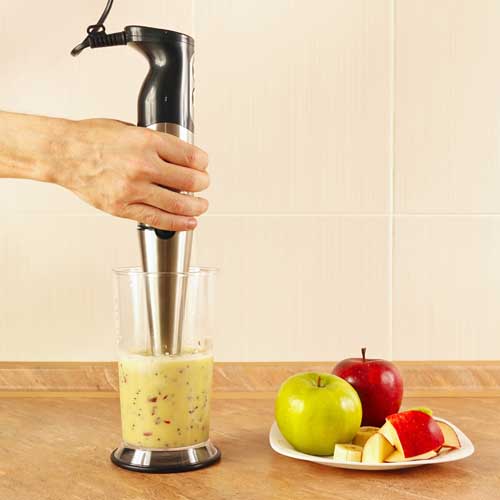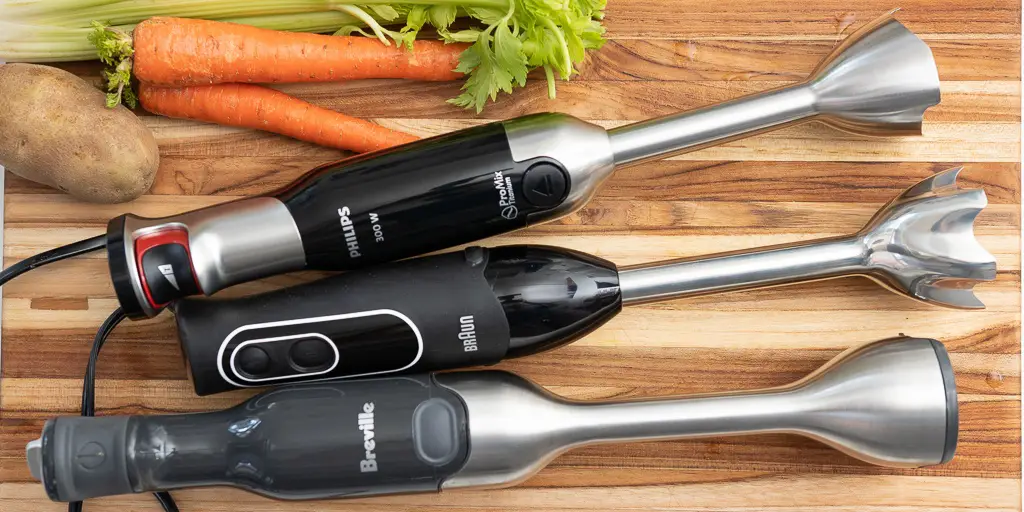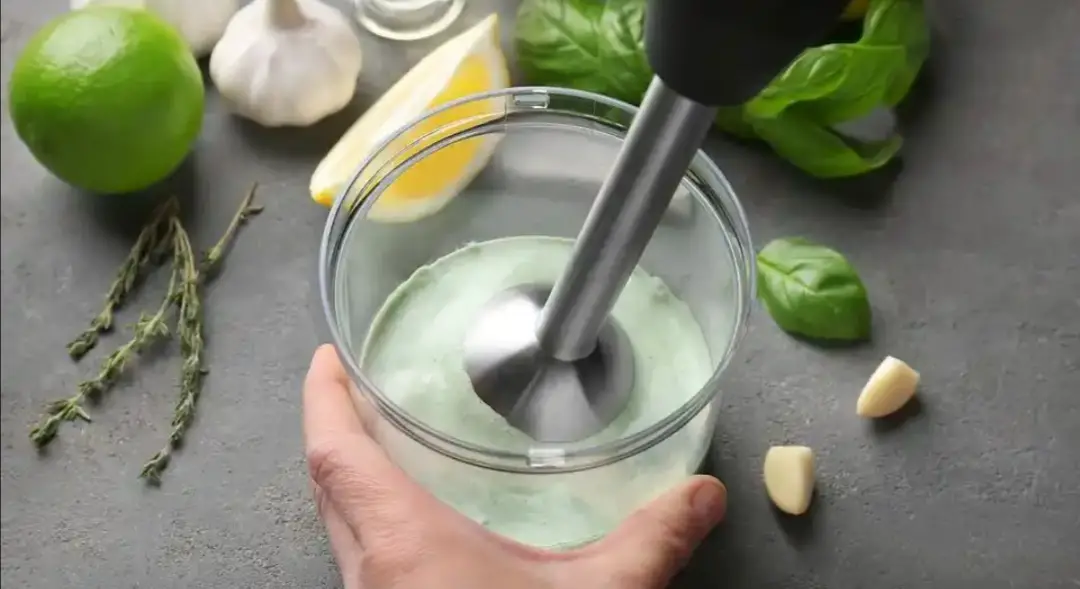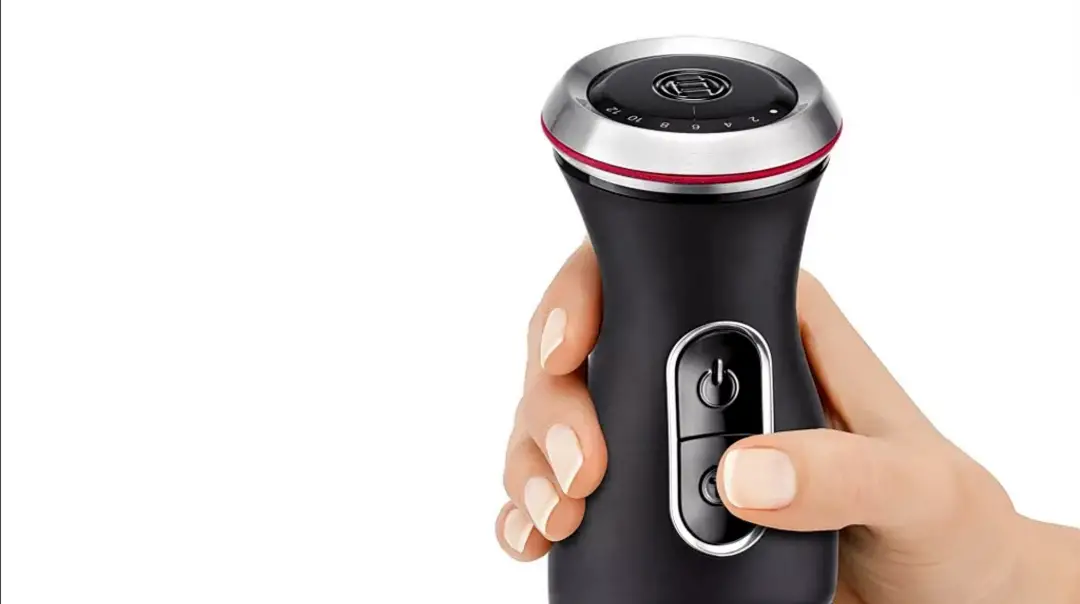For me though, I have both the counter-top blender and immersion blender in my kitchen and I haven’t even brought out the countertop from my cabinet in about one month now. The immersion blender has always been my go-to choice. Definitely worth every cent.
This has shaped the way I see the immersion blender now; from its simplicity, lightweight, ease of clean up to its ability to puree ingredients to my taste has made it my go-to choice of late. This is not to say the hand blender is better than the countertop, as an immersion blender would never be a replacement for a countertop blender, but it is to show you that even the immersion blender is a bag for its money and you should have one in your space.
Technically, an immersion blender is one of the best appliances to invest your money in when it comes to making pureed soups. They are really great for making sauces, vinaigrettes and mayonnaise, Whipping cream, smoothies, milkshakes as well as for blending soups.
While it may not work well for heavy-duty tasks, an immersion blender can effectively chop small quantities of herbs or nuts. Also note that there are some heavy-duty models of immersion blenders, too.
It may be true that an immersion blender will not work adequately in making silky-smooth texture. However, it is worth the investment when you want to use it for basic food preparation.
In addition, most cooks now choose to buy handy, easy to use, and lightweight appliance. This is a very obvious benefit of using an immersion blender. It is also cheaper than the regular stand blenders, making it a top choice.
On the other side of the coin, a lot of people do not really know how best an immersion blender can be utilized in the kitchen.
This spurs from the misunderstanding of what an immersion blender really is, how it works, what it is exactly used for, and how it can be used properly.
Let’s begin by understanding what an immersion blender really is and how it works.
Table of Contents
What is an immersion blender?

Immersion blenders are called various names but still mean the same thing. So don’t be confused when I refer to the appliance as hand blenders.
Immersion blenders, wand blenders, stick blenders, and hand blenders are all the same thing. It is a kitchen appliance used for blending soups, sauces, and other liquids.
It takes the shape of a stick with sharp blender blades attached at the end of it. These blades are usually made of stainless steel.
There is a huge difference between the regular stand blenders and an immersion blender. While the regular blender will require blending in batches, an immersion blender will help greatly when you have a large amount of pureed soups or other food items to work with.
But when it comes to hand blenders, you have to use a separate jar or bowl to hold the blended soup. Most immersion blenders come with separate jars for this purpose.
They are usually deep enough to prevent the liquids from spilling all over.
A very powerful immersion blender will work perfectly on cooked meats, potatoes, vegetables, and so on. These appliances are easy to carry around, easy to clean, and easy to use.
How does an immersion blender work?

So if you have no idea about what an immersion blender looks like, the image above is a typical example.
The appliance is made up of a metal stick or wand with a blender blade attached to one end and a switch where you can use to control the movement of the blades usually located at the other end of the wand.
This area is made with plastic in some models
Unlike stand blenders, it does not come with an attached work bowl. This means that you’ll need a separate container to hold your blended soup. It is used by holding the blender in the hand and inserting the other end that has the blade into the container containing food ingredients.
It is powered by a cord plugged into an outlet. By pressing the control button at the other end, it causes the motor to start functioning thereby making the blades rotate speedily.
It blends, stirs, purees, chops, and even emulsifies your ingredients.
These small but mighty blenders are really versatile and powerful and time-saving.
Immersion blenders, also known as hand blenders, comes with various attachments that makes it perfect for blending most food items. An ideal hand blender usually come with the following components:
- Chopper bowl
- Special sharp blades or attachments for blending, pureeing, chopping or shredding
- Whisk attachment
- Extension wand for blending in large containers
- Wall bracket, storage case or stand
- Whipping or beating attachment
Things that an immersion blender is used for
There is certain food prep that does more suit the use of an immersion blender. Many cooks mistake the need for a stand blender with that of an immersion blender.
So in this article, we will still look into the relationship and dissimilarities between these two. For now, here are the cooking operation that an immersion blender excels at.
- Vinaigrette and dressings
- Making milkshakes
- Blending soups
- Chunky salsa
- Making sauces and mayonnaise’s
- Whipping cream
- Smoothies without hard ingredients
- Chopping small quantities of herbs or nuts
- Beating eggs
- Making Dutch baby and pancake batter
With an immersion blender, you can simply blend soups in their original pot which means you don’t have to transfer blended food items from bowls or jars to anywhere. It’s a super easy process and saves on time.
Can immersion blenders replace stand blenders?

There is obviously a difference between an immersion blender and a stand blender when it comes to appearance and functionality. The hugest difference that sets both appliance apart is the power of each appliance.
Choosing to use an immersion blender instead of a stand blender depends on, not only your preference but also the particular cooking operation you want to carry out.
So to make things clearer, I have created this table to explain when it is absolutely necessary to use a stand blender and when it can be replaced with an immersion blender.
| When to use a stand blender | When to use an immersion blender |
|---|---|
| Smooth purées | Beating eggs |
| Creamy soups | Making whipped cream |
| Smoothies made with frozen fruit | Dutch baby and pancake batter |
| Creamy dips | Vinaigrette and dressings |
| Frozen cocktails | Smoothies without hard ingredients |
| Smoothies made with ice | Chunky salsa |
How to choose the best immersion blender
Just before you buy a hand blender, consider these features, and make sure they are part of the qualities of the product. An ideal hand blender should be equipped with the following features:
High Power
Do not make the mistake of choosing hand blenders with less power wattage especially if you want to be able to puree thicker liquids, grind nuts and seeds, crush ice and chop fruit and herbs with the appliance.
Usually, hand blenders come powered with different wattage ranging from 140 – 800 watts. A hand blender with low power will work very fine for blending thin liquids or making smoothies.
They usually come less expensive. For heavy-duty tasks, choose hand blenders that are powered with 700 watts and above.
Various Speed Settings
Not all hand blenders are designed with variable speed settings. The speed setting is what allows you to dictate the blending range and control.
Some basic hand blades feature only 2 speeds, while some have more than that.
Corded or Cordless hand blenders
Most people will choose a Cordless hand blender because it allows you to move around with it freely without bothering about the cords. But a corded hand blender holds the long-lasting power.
If you are going to choose a hand blender with cord, make sure the cord length is long enough to reach the area of use. The length of the cord is usually indicated in the product description. Go through the specifications before you buy.
Mind you, if you are choosing a Cordless hand blender, have it in mind that it’s going to be a little bit heavier than corded ones because of its battery. Speaking about the battery, it will require a regular charge to keep it running smoothly.
Easy to clean
It is best to choose immersion blenders with dishwasher safe parts that include the wands and other attachments. This will make the cleaning and maintenance process seemingly easy.
Appearance and Design
Before you buy a hand blender from a physical store, try to hold it and see how easy it is to handle it. A really heavy hand blender will not be easy to manoeuvre when using. An ideal immersion blender should be designed in such a way that the handle balances when held.
The blades at the other end of the wand should also be enclosed in a cup-like shape.
The Pulse button Option
To achieve a more consistent result, you need a hand blender with the pulse option. The pulse button is usually located at the top end of the wand.
It is used to give short bursts of power that will, in turn, redistribute the contents being blend in order to achieve an even result.

Length of the wand
Especially when you put your ingredients in a deeper container, you will need a hand blender with an extension wand. As you know, some models come with different wand length.
The length of the wand determines how deep the appliance can be immersed into the bowl, container, or jar.
How to clean immersion blenders

How do you clean and maintain an immersion blender? This may be a very difficult question to answer, not because of the process but because of what warrants proper cleaning.
After an immersion blender is used, some food particles and residues can find their way into the enclosed, Cup-like shape where the blender blades are located.
Now, this can get really tricky because you don’t want those blades to cut your fingers. There are different ways to go about it though. These steps I’m about to show you is the best way to clean your immersion blender and all the attachments to keep them shiny and sparkling.
- The first step is to grab a bowl and fill it with hot water and then apply liquid soap or detergent into the water. A drop or two would do. Make sure the water is filled above halfway upwards. (note that this step is to clean resistant food stuck into the attachments)
- Now that you have a bowl with soapy water, Immerse the hand blender in the water and push the ON button. In that way, you are literally blending the soapy water. The water solution is meant to fume up while the food particles glued to the attachment is being removed.
- Do this for some seconds and turn the blender off. Remove the blender from the container and place the blades under running water to rinse the soap away. After that, set it on a dry dish towel or drying rack and allow it to thoroughly dry before storing it.
- Just before you throw away the soapy water, you can use it to wipe down/ away from the food particles on the wand of the hand blender using a towel.
- The soap water can still be used to clean around the work area just in case you made any little mess while using the appliance.
- After cleaning properly, make sure the hand blender and all its attachments are thoroughly dried using a dishtowel. You also need to store it in a place that is free of dust assemblage and easy to access.
The best tip for maintaining immersion blenders is to clean it immediately after use!
Are you looking for the best immersion blenders to buy? Save yourself the stress of going online and searching for the best among tons of unqualified products. We’ve done the research for you! Check out this post that reviews the best-recommended immersion blenders to buy HERE
Downsides of using immersion blenders
Just like every other kitchen appliance, there are some little drawbacks when it comes to using stick blenders and it is important to be aware of them so that you can easily prevent them from happing.
A popular complaint about the use of hand blender is that it requires extreme care in order to prevent splashing, especially hot foods such as soup.
In general, you could make a huge mess at your first attempt at using a hand blender.
Secondly, even the best hand blender may not work well for blending or pureeing stiff or tough foods. They are not really designed for this purpose, unlike stand blenders.
It is not safe to let the kids handle your immersion blender as they could easily be exposed to the blades or even turn the kitchen wall to graffiti using food ingredients.
Lastly, an observable disadvantage of hand blenders is that they are only best at chopping, crushing, or grinding small amounts at a time.
Conclusion – Are Immersion Blenders worth it?
Most people today are now demanding more of kitchen appliances that are handy and will help them in performing tasks in the kitchen without much stress.
It has been realized by many users that Immersion blenders are worth investing in as the gradient of demand on this particular kitchen tool has been on a consistent rise in recent times.
